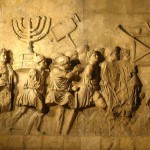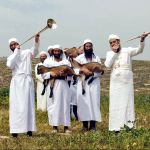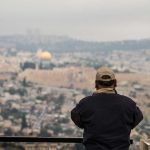“Then came the Feast of Dedication at Jerusalem. It was winter, and Jesus [Yeshua] was in the Temple area walking in Solomon’s Colonnade.” (John 10:22–23)
Some years ago, a group of Jewish visitors to the Temple Mount reported seeing ancient beams dated to the First and Second Temple period being used as firewood by the Arab community.
The beams were used in the construction of the Al-Aqsa Mosque and became visible to the public in the 1930s while the building was being refurbished. These beams may have originally been part of the Holy Temple’s roof structure.
Byzantine-era designs were also discovered etched on some of these beams.
“It appears that this is part of the systematic attempts by Arabs to destroy all connections between the Jewish people and the Temple Mount,” a spokesperson from one of the groups trying to secure Jewish rights on the Temple Mount said (Arutz Sheva).

Volunteers sift through debris irresponsibly excavated from the Temple Mount. (Photo by Zachi Dvira)
Despite Arab denial that any Jewish Temples ever existed on the Mount, and despite their unauthorized excavations on the Mount that destroy evidence of such a Jewish presence, there are groups of Jews and Christians planning to build a Third Temple on this holiest site in the world.
In fact, the furnishings, instruments, and vessels for Temple worship have already been created and are on display at the Holy Temple Visitors Center in Jerusalem.
“They shall make for me a sanctuary, and I will dwell among them.” (Exodus 25:8)

Three Israeli school children walk by the Temple Institute’s Holy Temple Visitors Center on Misgav Ladach Street in Jerusalem.
The Temple Institute
Just beyond the courtyard of the Western Wall in the Old City of Jerusalem is Misgav Ladach Street, a sheltered cobblestone road that leads Israelis and tourists to the Temple Institute (Machon HaMikdash). There, visitors can view Temple treasures that have not been seen in over 2,000 years.
The Temple Institute also offers group tours that can be organized ahead of time and given in Hebrew, English or other languages so that anyone can take in the well-documented history of the Jewish Temple.
A gift shop with Temple-themed books, posters, puzzles, games, jewelry, and replicas await visitors. But these items pale in comparison to the 25 years of research and craftmanship that the Institute has invested in creating the Temple treasures.

Water and Wine Libation Cups: Two silver cups were fixed on the top southwest corner of the Altar, one for water libation and the other for the wine. While the wine libation was to be poured every day, the water was poured only on Sukkot (Feast of Tabernacles).
These are no mere models or replicas. They have been created for use in the Third Temple, which could possibly be constructed within our lifetime. Every dazzling piece in the Institute’s collection is made of pure gold, silver, copper, and other authentic materials.
They have been crafted only after lengthy research into the designs and practices of the original Temple, as required in the Torah and Talmud (oral law). Researchers also studied images on ancient coins and other artifacts that survived the Second Temple era.

The silver vessel for the Wine Libation Ceremony: wine was poured out twice daily, once in the morning and once in the evening during the daily service.
The Institute relied on dozens of people—rabbis, scholars, scientists and other experts—who contributed their talents to recreate the Temple vessels.
According to its website, one of the Temple Institute is “dedicated to all aspects of the Divine commandment for Israel to build a house for G-d’s presence, the Holy Temple, on Mount Moriah in Jerusalem.”
So, in addition to the vessels and furnishings, a variety of paintings, which were commissioned by the Temple Institute, cover the exhibit walls.
Each one provides a rich context for understanding the various utensils, golden bowls, jugs for sanctified oil, the Golden Altar, Showbread Table, and other tools used for cleaning or preparing sacrifices that line the rooms.
The Temple Treasures on Display
The clothing and breastplate of the Kohen Gadol (High Priest) are on display along with instruments specific to prayer, sacred assembly, and musical worship.
This includes silver-plated shofars (ram’s horns) for fast days and gold-plated shofars for blowing on Rosh HaShanah (literally, Head of the Year, the Jewish New Year).
“On the first day of the seventh month you are to have a day of Sabbath rest, a sacred assembly commemorated with trumpet [shofar] blasts.” (Leviticus 23:24)
Silver trumpets used for public prayer and multiple lyres also line the walls. The lyres have 10 strings based upon verses in the Psalms.
“Praise the LORD with the harp; make music to Him on the ten-stringed lyre.” (Psalm 33:2–3; see also Psalms 71:22, 81:2 and 144:9)
Indeed, music played an important role in worship. “Every day, the Levites would play a special song for that day of the week, that could be heard from afar,” an exhibit states.
“All the Levites who were musicians—Asaph, Heman, Jeduthun and their sons and relatives—stood on the east side of the altar, dressed in fine linen and playing cymbals, harps and lyres. They were accompanied by 120 priests sounding trumpets.” (2 Chronicles 5:12)
Symbolic Treasures: A Journey to Wholeness
“Every morning and evening they present burnt offerings and fragrant incense to the LORD. They set out the bread on the ceremonially clean table and light the lamps on the gold lampstand every evening.” (2 Chronicles 13:11)
The Institute also highlights three pieces from the Holy Sanctuary that are symbolically linked:
- the Menorah (Exodus 25:31–40), signifying spiritual blessing;
- the Shulkan (Exodus 25:30), which held the Lechem HaPanim (Showbread), signifying physical blessing; and
- the Golden Altar (Exodus 30: 1–9) between them, on which the Ketores (Incense Offering) burned as a physical element that was “transformed into spiritual.”
“The three vessels of the Sanctuary thus signify the correct balance of life; a mixture of the spiritual and physical worlds that brings the human soul to wholeness,” an exhibit sign explains.

The gold Menorah is on public display and overlooks the Western Wall Plaza, across from the Temple Mount.
The Menorah
Although the table and vessels for the oil and incense are on display inside the Temple Institute, the Menorah stands outside in full view in the Old City’s Jewish Quarter, which is fitting since its light would have been visible during Temple times.
The Menorah had a central role because it is a sign of God’s Shekhinah (Divine Presence) among B’nai Yisrael (Children of Israel) and is symbolic of spiritual illumination. It was, therefore, the first sacred vessel to be recreated since the Second Temple was destroyed in AD 70.
Although the Menorah sits outside, the Menorah’s two-litre oil pitcher, used to replenish oil in the jug that feeds the golden menorah, is on display inside the Institute.
Along with the Menorah, this was the vessel involved in the miracle of Hanukkah. After defeating the Greek invaders, the Hasmonean priests found such a pitcher, which was sealed to protect the purity of its oil.

The tall jug contains enough menorah oil for all seven lamps. That oil is poured into the smaller gold jug (bottom left) that is used to replenish the individual lamps. The bowl with the tongs and brush is for cleaning the Menorah.
The Table of the Showbread
Exodus 25 provides instructions for the design of the Table of the Showbread, which stood within the Sanctuary in Jerusalem.
Twelve loaves of bread called Lechem HaPanim (Bread of the Presence) were to be on this table to stand before God at all times.
“This bread is to be set out before the LORD regularly, Sabbath after Sabbath, on behalf of the Israelites, as a lasting covenant.” (Leviticus 24:8, see also Exodus 25:30; Numbers 4:7; 2 Chronicles 2:4; 1 Kings 7:48; Hebrews 9:2)
Leviticus 24 describes how these loaves were to be made and placed on the Golden Altar.
“Take fine flour and bake twelve loaves of bread, using two-tenths of an ephah for each loaf. Set them in two rows, six in each row, on the table of pure gold before the Lord. Along each row put some pure incense as a memorial portion ….” (Leviticus 24:5–7)
The Talmud (oral tradition) states that these loaves miraculously remained fresh and hot all week—just like freshly baked bread, and that this was taken as a confirmation of the Divine Presence (Shekhinah).
The bread symbolized, among other things, God’s providence and physical provision.

The Table of the Showbread stood on the northern side of the Sanctuary. It is made of wood overlaid with gold.
The Incense Offering
Like the light of the Menorah shining forth from the Temple windows, the incense offering also had a palpable presence during Temple times. It is believed that its aroma would travel 25 miles beyond the Temple itself, connecting the greater community with this offering of worship.
An institute sign explains how the incense was offered:
“Once the coals were on the Golden Altar [Mizbach HaZahav], one priest would pour the incense spice mixture from the chalice into the second priest’s hand. The second priest would then sprinkle the incense over the coals and a wonderful aroma would fill the sanctuary.”
This incense was sacred, and its formulation was a closely guarded secret, passed down through the generations.

The incense chalice (left), and the shovel (right) for bringing coals from the outer altar to the Golden Incense Altar.
Exodus 30:34 identifies four of the 11 ingredients: balsam, onycha, galbanum, and pure frankincense. The Bible does not identify the herb that caused the smoke to rise in a straight column, which is called Ma’aleh Ashan, or the other spices.
The Torah makes it plain why this formulation was guarded:
“Whoever makes perfume like it and whoever puts it on anyone other than a priest must be cut off from his people.” (Exodus 30:33)
For that reason, even though the priest offered it on the Golden Altar, according to the Talmud (oral tradition), only one family—the Avtinas—knew the identity of the spices, as well as the exact amounts and the manner they were prepared.

Copper vessels: On the left is the Abuv, a three-tiered stand used for roasting the Omer on Passover. The middle tier contains coal for roasting the barley. On the far right toward the back is the copper vessel used in preparing the meal offering.
Rebuilding the Temple in the Last Days
“My house will be called a house of prayer for all nations.” (Isaiah 56:7)
The Temple Institute is entirely dedicated to rebuilding the Temple on the Temple Mount.
A major obstacle to the realization of that goal is the presence of two Islamic structures now occupying part of the Temple Mount: the Dome of the Rock and the Al-Aqsa Mosque.
While Jews look forward to the building of the Temple as a beacon of hope and spiritual reconciliation for the entire world, Believers in Yeshua and the Brit Chadashah understand another reality for the Temple and for the world.
In the Last Days, the “man of lawlessness” will “oppose and exalt himself over everything that is called God or is worshiped, so that he sets himself up in God’s temple, proclaiming himself to be God.” (2 Thessalonians 2:4)
Who could this man of lawlessness be? How will we know when he has arrived?
Daniel gives us good clues:
“He will confirm a covenant with many for one ‘seven.’ In the middle of the ‘seven’ he will put an end to sacrifice and offering. And at the temple he will set up an abomination that causes desolation, until the end that is decreed is poured out on him.” (Daniel 9:27)
Some translations don’t use the word “Temple,” but the idea is similar: the man of lawlessness will do what is detestable to the Lord, and according to the Brit Chadashah (New Testament), he will clearly do it in the Temple for all the world to see.
The Last Days are here and two things remain before the Anti-Messiah arrives on the scene: the building of the Temple and the confirming of a covenant with Israel.
Those two events are in sight.
Please support our Bibles For Israel Ministry so Israel and the nations may understand these and other revelations found throughout His Word.
“I make known the end from the beginning, from ancient times, what is still to come. I say, ‘My purpose will stand, and I will do all that I please.'” (Isaiah 46:10)









































